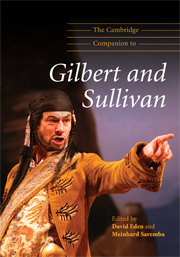Book contents
- Frontmatter
- Part I Background
- Part II Focus
- 5 The operas in context: stylistic elements – the Savoy and beyond
- 6 The librettos in context: Gilbert's ‘fables in song’
- 7 ‘This particularly rapid, unintelligible patter’: patter songs and the word–music relationship
- 8 Standing still and moving forward: The Mikado, Haddon Hall and concepts of time in the Savoy operas
- 9 Musical contexts I: motives and methods in Sullivan's allusions
- 10 Musical contexts II: characterisation and emotion in the Savoy operas
- Part III Reception
- Part IV Into the twenty-first century
- Appendix 1 Who wrote the overtures?
- Appendix 2 Stage and choral works by Arthur Sullivan and W. S. Gilbert
- Appendix 3 Modern editions of works by Arthur Sullivan and W. S. Gilbert
- Appendix 4 Sullivan's archetypes of English opera
- Notes
- Bibliography and further reading
- Index
- Plate section
6 - The librettos in context: Gilbert's ‘fables in song’
from Part II - Focus
Published online by Cambridge University Press: 28 September 2011
- Frontmatter
- Part I Background
- Part II Focus
- 5 The operas in context: stylistic elements – the Savoy and beyond
- 6 The librettos in context: Gilbert's ‘fables in song’
- 7 ‘This particularly rapid, unintelligible patter’: patter songs and the word–music relationship
- 8 Standing still and moving forward: The Mikado, Haddon Hall and concepts of time in the Savoy operas
- 9 Musical contexts I: motives and methods in Sullivan's allusions
- 10 Musical contexts II: characterisation and emotion in the Savoy operas
- Part III Reception
- Part IV Into the twenty-first century
- Appendix 1 Who wrote the overtures?
- Appendix 2 Stage and choral works by Arthur Sullivan and W. S. Gilbert
- Appendix 3 Modern editions of works by Arthur Sullivan and W. S. Gilbert
- Appendix 4 Sullivan's archetypes of English opera
- Notes
- Bibliography and further reading
- Index
- Plate section
Summary
The nineteenth century abounded in parables, contes, emblematic tales, reveries, etc., and fables of the Aesopian type had their fair share of this blossoming. It can be shown that in the course of the century the latter tended to evolve from vessels of instruction, often at schools, into rather brittle repositories of humour, if not plain nonsense. In a light-hearted vein, the most common narrative structures of the fable – a problem or confrontation, their complication by an idiosyncratic action, and a pointed ending – often suffered parody. In a different context, that of shop ballads, they underwent humorous erotic re-encoding. A popular book of the time representative of both tendencies is Fables in Song, a collection that Edward Robert Bulwer, First Earl of Lytton, the son of the novelist, brought out in 1874, seven years before Gilbert's and Sullivan's Patience. In their verbal wit and their sheer exuberance of linguistic play, abounding in allusion and pastiche, Bulwer's two volumes specifically invite comparison with Gilbertian fable persiflage.
Fables in abundance
The best-known milkmaid in English musical drama lends her name to a spoof on the aesthetic craze of the 1890s. One of its main targets, poor poetic Grosvenor, deprived of Patience (as, no less, of patience), despairs of getting away from the love-lorn maidens who pursue him: ‘Oh, Patience … Alas, they will die of hopeless love for me, as I shall die of hopeless love for thee!’ In this quandary, the Poet, as a last resort, attempts to read to them two of his poems (not exactly mind-stunning achievements), which, fable-wise, have heavy morals attached to them. Here are the endings of tales of Gentle Jane (‘who was good as gold’) and Teasing Tom (‘a very bad boy’):
…And when she grew up (Jane) was given in marriage
To a first-class earl who keeps his carriage!
…The consequence was (Tom) was lost totálly
And married a girl in the corps de bally!
- Type
- Chapter
- Information
- The Cambridge Companion to Gilbert and Sullivan , pp. 85 - 97Publisher: Cambridge University PressPrint publication year: 2009



